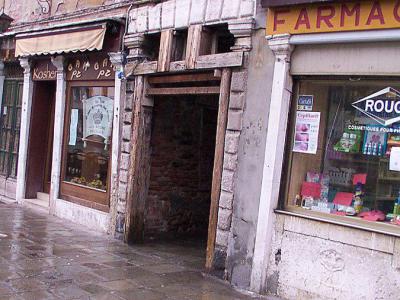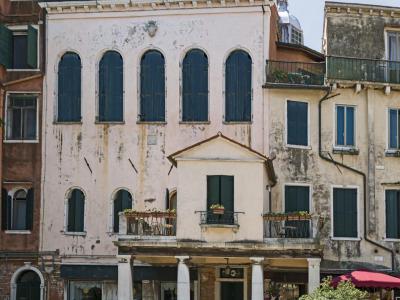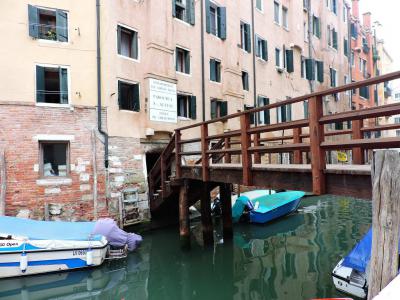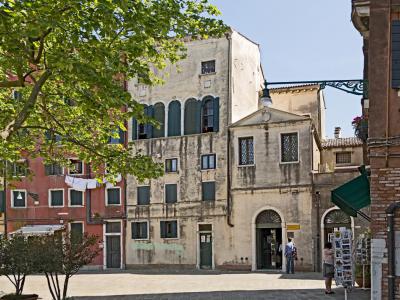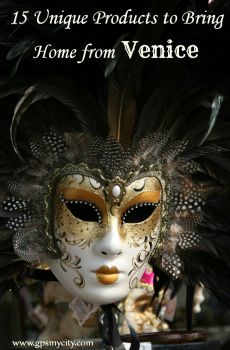Jewish Ghetto Tour (Self Guided), Venice
Founded in 1516, the Jewish Ghetto in Venice was the oldest of its kind in all Europe. At the time, Venice received order from the Pope to expel all Jews from the city, but the Venetian government opted to lock them onto a small island in the district of Cannaregio. Since then this small area has been the center of Jewish life in Venice, with buildings rising vertically to accommodate the rising number of Jews. By the mid-17th century the population numbered over 5,000. It wasn’t until 1866 that they were granted their freedom, following which they acquired citizenship and dispersed.
Today the Ghetto is enjoying something of a revival and is definitely worth a walk-through, as it comprises a Jewish school, great bookshops, a kosher restaurant, a Jewish bakery and some amazing old synagogues that you must visit – even if from the outside only. There are five of them in all, two of which are still in use, hidden from sight behind the ghetto’s walls – which is too bad, as they have been there for a long, long time and are truly little treasure boxes. While walking from one to another, look out also for the (rather moving) brass plaques in the paving outside doorways where Jews were arrested and sent to German camps during WWII.
End your trip at the Jewish Museum, which, despite the very strict security, has a great sense of community, housing a collection of artifacts from the 17th to 19th centuries. Regardless of whether you enter the museum, take some time to wander around the tranquil square in front, with its impressive memorials on the walls.
To see a different side of Venice, off the beaten path, and witness Jewish life in Europe's oldest ghetto, follow this self-guided walking tour.
Getting to Sight #1. The first tour stop (Entrance to the Old Jewish Ghetto) can be reached by: Alilaguna Water Taxi: Arancio (A), Water Bus: 4.1, 4.2, 5.1, 5.2.
Today the Ghetto is enjoying something of a revival and is definitely worth a walk-through, as it comprises a Jewish school, great bookshops, a kosher restaurant, a Jewish bakery and some amazing old synagogues that you must visit – even if from the outside only. There are five of them in all, two of which are still in use, hidden from sight behind the ghetto’s walls – which is too bad, as they have been there for a long, long time and are truly little treasure boxes. While walking from one to another, look out also for the (rather moving) brass plaques in the paving outside doorways where Jews were arrested and sent to German camps during WWII.
End your trip at the Jewish Museum, which, despite the very strict security, has a great sense of community, housing a collection of artifacts from the 17th to 19th centuries. Regardless of whether you enter the museum, take some time to wander around the tranquil square in front, with its impressive memorials on the walls.
To see a different side of Venice, off the beaten path, and witness Jewish life in Europe's oldest ghetto, follow this self-guided walking tour.
Getting to Sight #1. The first tour stop (Entrance to the Old Jewish Ghetto) can be reached by: Alilaguna Water Taxi: Arancio (A), Water Bus: 4.1, 4.2, 5.1, 5.2.
How it works: Download the app "GPSmyCity: Walks in 1K+ Cities" from Apple App Store or Google Play Store to your mobile phone or tablet. The app turns your mobile device into a personal tour guide and its built-in GPS navigation functions guide you from one tour stop to next. The app works offline, so no data plan is needed when traveling abroad.
Jewish Ghetto Tour Map
Guide Name: Jewish Ghetto Tour
Guide Location: Italy » Venice (See other walking tours in Venice)
Guide Type: Self-guided Walking Tour (Sightseeing)
# of Attractions: 9
Tour Duration: 1 Hour(s)
Travel Distance: 0.4 Km or 0.2 Miles
Author: DanaOffice
Sight(s) Featured in This Guide:
Guide Location: Italy » Venice (See other walking tours in Venice)
Guide Type: Self-guided Walking Tour (Sightseeing)
# of Attractions: 9
Tour Duration: 1 Hour(s)
Travel Distance: 0.4 Km or 0.2 Miles
Author: DanaOffice
Sight(s) Featured in This Guide:
- Entrance to the Old Jewish Ghetto
- Scuola Spagnola (Spanish Synagogue)
- Scuola Levantina (Levantine Synagogue)
- Scuola Italiana (Italian Synagogue)
- Banco Rosso (Red Bank)
- Entrance to the New Jewish Ghetto
- Scuola Tedesca (German Synagogue)
- Scuola Canton (Canton Synagogue)
- Museo Ebraico (Jewish Museum of Venice)
1) Entrance to the Old Jewish Ghetto
This gateway serves as the main entrance to the historic Old Jewish Ghetto in Venice. Its significance stems from the decree issued on March 29, 1516, which resulted in the installation of guarded gates at the Ghetto's entrances.
These gates were tightly closed at sunset, effectively confining the Jewish community within, until the break of day signaled by the resonating chimes of the Marangona, the grand bell housed within the bell tower of Saint Mark's Basilica. Despite the imposed restrictions, some resourceful individuals would clandestinely negotiate their way out by offering monetary compensation. This state of affairs endured until the advent of Napoleon and the French army in 1796, when the weighty "gates of infamy" were ultimately torn down and consigned to flames, liberating the Ghetto from its oppressive confines.
These gates were tightly closed at sunset, effectively confining the Jewish community within, until the break of day signaled by the resonating chimes of the Marangona, the grand bell housed within the bell tower of Saint Mark's Basilica. Despite the imposed restrictions, some resourceful individuals would clandestinely negotiate their way out by offering monetary compensation. This state of affairs endured until the advent of Napoleon and the French army in 1796, when the weighty "gates of infamy" were ultimately torn down and consigned to flames, liberating the Ghetto from its oppressive confines.
2) Scuola Spagnola (Spanish Synagogue)
The Spanish Synagogue stands as one of the two synagogues that still hold daily services in the Jewish Ghetto of Venice; open for services from Passover until the end of the High Holiday season. Founded by Jews who had been expelled from the Iberian Peninsula in the 1490s and found refuge in Venice (typically via Amsterdam, Livorno, or Ferrara, during the 1550s), it stands as a testament to their enduring spirit. Among all the synagogues in Venice, the Spanish Synagogue reigns supreme in terms of size, opulence, and renown.
The four-story yellow stone building was constructed in 1580 and was restored in 1635 by Baldassare Longhena, architect of numerous Venetian "scuole" and palaces. Initially a clandestine synagogue, it was tolerated on the condition that it be concealed within a building that gives no appearance being a house of worship form the exterior. The interior, on the other hand, is elaborately decorated, containing three large chandeliers and a dozen smaller ones, as well as a huge sculpted wooden ceiling.
In the hall, to the left is a small Midrash which has retained its original characteristics. On the back wall there is a tablet with the names of the Jews deported from Venice in the years 1943-44 while numerous other tablets on the side walls commemorate many members of well known Venetian families: Treves, Maurogonato, Gentilomo, Belilios, Coen, Caravaglio. On the stairs one finds an ancient alms box.
The four-story yellow stone building was constructed in 1580 and was restored in 1635 by Baldassare Longhena, architect of numerous Venetian "scuole" and palaces. Initially a clandestine synagogue, it was tolerated on the condition that it be concealed within a building that gives no appearance being a house of worship form the exterior. The interior, on the other hand, is elaborately decorated, containing three large chandeliers and a dozen smaller ones, as well as a huge sculpted wooden ceiling.
In the hall, to the left is a small Midrash which has retained its original characteristics. On the back wall there is a tablet with the names of the Jews deported from Venice in the years 1943-44 while numerous other tablets on the side walls commemorate many members of well known Venetian families: Treves, Maurogonato, Gentilomo, Belilios, Coen, Caravaglio. On the stairs one finds an ancient alms box.
3) Scuola Levantina (Levantine Synagogue)
The Levantine Synagogue, constructed by Jewish immigrants from the Eastern Mediterranean between 1538 and 1561, stands as a remarkable example of architectural preservation. It has retained nearly all of its original features, characterized by two simple facades interrupted by three rows of windows and a distinctive polygonal niche, a typical element of Venetian architecture.
The grand interior hall of the synagogue received a meticulous restoration in the late 17th century by the esteemed wood sculptor Andrea Brustolon from Belluno, who enjoyed great recognition in Venice at that time. The hall's splendor is exemplified by the exquisite woodworked pulpit, showcasing Brustolon's remarkable craftsmanship.
Upon entering the Scola's entrance hall, adorned with a beautiful ceiling, your attention will be drawn to two ancient tablets. The first tablet bears the inscription: "If you understand, oh man, what your end in the world will be, and if you show discreet charity, then when you depart this life, your place will be assured. Then your chalice will be filled with goodness, and a crown will be placed upon your head." Above the alms-box, the second tablet reads: "Donated by the Compagnia di Pietà e Misericordia."
To the right of the entrance hall, you will find the Jeshivà Luzzatto, a small and exquisite study and Prayer Hall that has been transferred intact from its original location. Adorned with various poems that offer praise to God, these verses form the acrostic of Eliahu Aron Hazach using their initial letters. Recent inscriptions serve as reminders that this prayer hall was chosen in 1950 to honor the victims of Nazism and Fascism. Above the portal, an inscription reads: "Blessed be he who enters, blessed be he who goes out."
The grand interior hall of the synagogue received a meticulous restoration in the late 17th century by the esteemed wood sculptor Andrea Brustolon from Belluno, who enjoyed great recognition in Venice at that time. The hall's splendor is exemplified by the exquisite woodworked pulpit, showcasing Brustolon's remarkable craftsmanship.
Upon entering the Scola's entrance hall, adorned with a beautiful ceiling, your attention will be drawn to two ancient tablets. The first tablet bears the inscription: "If you understand, oh man, what your end in the world will be, and if you show discreet charity, then when you depart this life, your place will be assured. Then your chalice will be filled with goodness, and a crown will be placed upon your head." Above the alms-box, the second tablet reads: "Donated by the Compagnia di Pietà e Misericordia."
To the right of the entrance hall, you will find the Jeshivà Luzzatto, a small and exquisite study and Prayer Hall that has been transferred intact from its original location. Adorned with various poems that offer praise to God, these verses form the acrostic of Eliahu Aron Hazach using their initial letters. Recent inscriptions serve as reminders that this prayer hall was chosen in 1950 to honor the victims of Nazism and Fascism. Above the portal, an inscription reads: "Blessed be he who enters, blessed be he who goes out."
4) Scuola Italiana (Italian Synagogue)
Erected in 1575, the Italian Synagogue stands as the last testament to the synagogues constructed during the reign of the Venetian Republic. Its distinctive features are immediately recognizable from the exterior, featuring five grand arched windows and a small Baroque dome perched above the apse. Upon the wall, a crest proudly proclaims the presence of the "Holy Italian Community in the year 1575" while a small tablet serves as a poignant reminder of the Temple's destruction.
To access the synagogue, one must pass through a modest portal and ascend narrow stairs, a deliberate design to conceal its sacred purpose. Once inside, a smaller and less ornate space reveals itself, reflecting the humble economic circumstances of the community adhering to the Italian rite. Worship conducted in Italian and Hebrew according to the Italkim tradition filled this sanctuary, which accommodated a mere 25 worshippers.
The interior is a slightly elongated rectangular shape, its Holy Ark ("aron kodesh") adorned with delicate wooden ornaments, culminating in a weighty pinnacle. A notable feature is the 18th-century bimah pulpit, gracefully projecting from a polygonal apse. Meanwhile, the stairs showcase elegant banisters embellished with a crossed arch motif, a hallmark of 18th-century Venetian furniture. Gilded inscriptions on the walls commemorate renovations and generous donations, with the earliest recorded in 1740. Beneath the teva (pulpit), one can read the words, "the tower of the House of our Lord was renovated in 5549 (1789)". Further remodeling efforts are documented to have taken place in 1842.
In honor of Save Venice's 50th Anniversary in 2021, extensive conservation projects are currently underway at the Italian Synagogue, safeguarding its cultural and historical significance for future generations.
To access the synagogue, one must pass through a modest portal and ascend narrow stairs, a deliberate design to conceal its sacred purpose. Once inside, a smaller and less ornate space reveals itself, reflecting the humble economic circumstances of the community adhering to the Italian rite. Worship conducted in Italian and Hebrew according to the Italkim tradition filled this sanctuary, which accommodated a mere 25 worshippers.
The interior is a slightly elongated rectangular shape, its Holy Ark ("aron kodesh") adorned with delicate wooden ornaments, culminating in a weighty pinnacle. A notable feature is the 18th-century bimah pulpit, gracefully projecting from a polygonal apse. Meanwhile, the stairs showcase elegant banisters embellished with a crossed arch motif, a hallmark of 18th-century Venetian furniture. Gilded inscriptions on the walls commemorate renovations and generous donations, with the earliest recorded in 1740. Beneath the teva (pulpit), one can read the words, "the tower of the House of our Lord was renovated in 5549 (1789)". Further remodeling efforts are documented to have taken place in 1842.
In honor of Save Venice's 50th Anniversary in 2021, extensive conservation projects are currently underway at the Italian Synagogue, safeguarding its cultural and historical significance for future generations.
5) Banco Rosso (Red Bank)
In medieval Europe, Jewish individuals faced limited options for livelihood due to societal restrictions. They were often confined to specific trades, such as dealing in used cloth, practicing medicine (doctors were the only people allowed out of the Ghetto at night), and engaging in money lending. The latter role became significant as Christians were forbidden by the Church to lend money at interest, creating a void that Jewish communities filled by offering cash loans.
Venice, in particular, had three banks distinguished by color: red, green, and black. These establishments were a combination of banks and pawnshops, where individuals could pledge an item in exchange for a loan. It is believed that these banks were among the earliest pawnshops in the world and operated until the end of the Venetian Republic in 1797. The intriguing nature of their commercial activities is even captured in William Shakespeare's renowned play, "The Merchant of Venice".
Today, visitors have the opportunity to explore one of these historic banks, known as the Red Bank ("Banco Roso"), which has been restored and is open for public viewing. The name "Red Bank" stems from the red receipt given to customers when they pawned an item. Interestingly, some speculate that the term "in the red", referring to financial indebtedness, may have originated from the practices of these ancient Venetian pawnbrokers.
Venice, in particular, had three banks distinguished by color: red, green, and black. These establishments were a combination of banks and pawnshops, where individuals could pledge an item in exchange for a loan. It is believed that these banks were among the earliest pawnshops in the world and operated until the end of the Venetian Republic in 1797. The intriguing nature of their commercial activities is even captured in William Shakespeare's renowned play, "The Merchant of Venice".
Today, visitors have the opportunity to explore one of these historic banks, known as the Red Bank ("Banco Roso"), which has been restored and is open for public viewing. The name "Red Bank" stems from the red receipt given to customers when they pawned an item. Interestingly, some speculate that the term "in the red", referring to financial indebtedness, may have originated from the practices of these ancient Venetian pawnbrokers.
6) Entrance to the New Jewish Ghetto
Located in the Cannaregio district of Venice, the Ghetto comprises two distinct sections: the New Ghetto ("Ghetto Nuovo") and the adjacent Old Ghetto ("Ghetto Vecchio"). The names assigned to these sections can be misleading, as they actually refer to their use by the foundries rather than the chronology of residency. Interestingly, the New Ghetto predates the Old Ghetto in terms of Jewish settlement.
To maintain a sense of isolation, the Ghetto was connected to the rest of the city by two bridges that were only accessible during daylight hours, further emphasizing the insular nature of Venice. The surrounding canals encircling this small and regular-shaped island provided a convenient means of surveillance. Here lies the primary entrance to the New Jewish Ghetto.
To maintain a sense of isolation, the Ghetto was connected to the rest of the city by two bridges that were only accessible during daylight hours, further emphasizing the insular nature of Venice. The surrounding canals encircling this small and regular-shaped island provided a convenient means of surveillance. Here lies the primary entrance to the New Jewish Ghetto.
7) Scuola Tedesca (German Synagogue)
The German Synagogue, constructed by the Ashkenazi community around 1528, holds the distinction of being the oldest among the synagogues in Venice. Its unassuming location on the top floor of a building allows it to blend seamlessly with its surroundings, save for the graceful presence of five white stone arches. Above the cornice, an inscription proclaims, "Scuola Grande of the German Holy Community; may God protect them, Amen". Inside, marble-clad walls and the gilded Ten Commandments against a backdrop of red create a captivating atmosphere that envelops the worship hall.
Together with its neighboring counterpart, the Canton Synagogue, completed in 1532, the German Synagogue represents the early influence of the Ashkenazi community in the formative years of the Ghetto, preceding the arrival of wealthier Jewish merchants from Spain and the Levant in the 1550s.
Like other synagogues in Venice, the German Synagogue ceased regular use in October 1917, when the local Jewish community was disbanded. Subsequently, the administration of all Jewish places of worship was consolidated under a single institution known as the Templi Israelitici Uniti.
Together with its neighboring counterpart, the Canton Synagogue, completed in 1532, the German Synagogue represents the early influence of the Ashkenazi community in the formative years of the Ghetto, preceding the arrival of wealthier Jewish merchants from Spain and the Levant in the 1550s.
Like other synagogues in Venice, the German Synagogue ceased regular use in October 1917, when the local Jewish community was disbanded. Subsequently, the administration of all Jewish places of worship was consolidated under a single institution known as the Templi Israelitici Uniti.
8) Scuola Canton (Canton Synagogue)
The Canton Synagogue is recognizable by the tiny wooden room with a small, rounded turret atop. Its name originates from either the family that sponsored its construction or its location in the "canton" (Venetian dialect for "corner") of the Ghetto Square. As the second synagogue to be built in Venice, it took shape in the 1530s with financial support from German, French, and Swiss Jews. Over time, it underwent expansions and embellishments, particularly in the 18th century, reflecting the ornate style of the Baroque era. Inscribed above the entrance portal, one can read: "Year of the construction of the Holy Community Canton Synagogue 5292 (1532)".
Upon ascending the stairs, a tablet catches the eye at the first doorway, bearing the words: "Free yourself, mortal, from evil desires when you step foot in the Temple to pray, consider to whom you are praying, and with devout faith, direct your thoughts to your Divine Subject". Above the second doorway, a verse from Solomon's Proverbs is displayed: "Blessed is the man that heareth me, watching daily at my gates". Just like the German Synagogue, this sanctuary adheres to the Ashkenazi rite.
The synagogue is bathed in natural light, thanks to its eleven large windows that open up to the outside. Inside, the Baroque-style decor takes center stage, adorned with elements of Rococo design. At opposite ends of the sanctuary, the main focal points-the bimah and the ark-hold prominence. What makes this synagogue unique is its "bifocal effect", as it was the first in Venice to be built with the pulpit placed in the middle of the room, conforming to the traditional configuration of a central bimah.
Upon ascending the stairs, a tablet catches the eye at the first doorway, bearing the words: "Free yourself, mortal, from evil desires when you step foot in the Temple to pray, consider to whom you are praying, and with devout faith, direct your thoughts to your Divine Subject". Above the second doorway, a verse from Solomon's Proverbs is displayed: "Blessed is the man that heareth me, watching daily at my gates". Just like the German Synagogue, this sanctuary adheres to the Ashkenazi rite.
The synagogue is bathed in natural light, thanks to its eleven large windows that open up to the outside. Inside, the Baroque-style decor takes center stage, adorned with elements of Rococo design. At opposite ends of the sanctuary, the main focal points-the bimah and the ark-hold prominence. What makes this synagogue unique is its "bifocal effect", as it was the first in Venice to be built with the pulpit placed in the middle of the room, conforming to the traditional configuration of a central bimah.
9) Museo Ebraico (Jewish Museum of Venice)
Originally established in 1954, the Jewish Museum of Venice is a treasure trove of valuable artistic artifacts that beautifully depict the rich history and culture of Venetian Jews.
The museum is thoughtfully organized into four thematic sections. The first unveils a collection of ritual silver objects, providing a insight into the annual festivals and religious practices of the community. The second section features an impressive display of exquisite textile artifacts, showcasing the intricate craftsmanship and beauty of textiles used to adorn the Torah scrolls and embellish the synagogue.
A spacious hall offers a comprehensive overview of the major historical events that shaped the Venetian Jewish community, from the successive waves of immigration to the social and cultural expressions that have defined each era. To conclude the experience, visitors are invited into a dedicated room that shines a spotlight on the key events that form the cycle of Jewish life.
Additionally, visitors can independently explore the well-stocked Alef museum bookshop. Located adjacent to the ticket office, it offers a wealth of literary treasures and educational resources, ensuring a journey of discovery beyond the museum's walls.
Why You Should Visit:
Alongside its captivating exhibitions on the historical aspects of Jewish life in the ghetto, the museum presents a unique opportunity to delve further into the rich heritage by exploring three ancient synagogues for a nominal additional charge. These synagogues provide an insightful glimpse into the rich heritage of the community.
Even for those who opt not to enter the museum, the Ghetto Nuovo square is a destination of its own. With its picturesque charm and tranquil ambiance, it offers a serene escape from the bustling areas of the city.
Tip:
Be sure to allocate some time to explore the charming streets of the Ghetto area, as you will come across a variety of delightful and distinctive restaurants and bodegas offering their own unique flavors and experiences.
The museum is thoughtfully organized into four thematic sections. The first unveils a collection of ritual silver objects, providing a insight into the annual festivals and religious practices of the community. The second section features an impressive display of exquisite textile artifacts, showcasing the intricate craftsmanship and beauty of textiles used to adorn the Torah scrolls and embellish the synagogue.
A spacious hall offers a comprehensive overview of the major historical events that shaped the Venetian Jewish community, from the successive waves of immigration to the social and cultural expressions that have defined each era. To conclude the experience, visitors are invited into a dedicated room that shines a spotlight on the key events that form the cycle of Jewish life.
Additionally, visitors can independently explore the well-stocked Alef museum bookshop. Located adjacent to the ticket office, it offers a wealth of literary treasures and educational resources, ensuring a journey of discovery beyond the museum's walls.
Why You Should Visit:
Alongside its captivating exhibitions on the historical aspects of Jewish life in the ghetto, the museum presents a unique opportunity to delve further into the rich heritage by exploring three ancient synagogues for a nominal additional charge. These synagogues provide an insightful glimpse into the rich heritage of the community.
Even for those who opt not to enter the museum, the Ghetto Nuovo square is a destination of its own. With its picturesque charm and tranquil ambiance, it offers a serene escape from the bustling areas of the city.
Tip:
Be sure to allocate some time to explore the charming streets of the Ghetto area, as you will come across a variety of delightful and distinctive restaurants and bodegas offering their own unique flavors and experiences.
Walking Tours in Venice, Italy
Create Your Own Walk in Venice
Creating your own self-guided walk in Venice is easy and fun. Choose the city attractions that you want to see and a walk route map will be created just for you. You can even set your hotel as the start point of the walk.
Murano Island Walking Tour
Murano is often called the Glass Island, since it is home to the most impressive and renowned Venetian glass factories. The master craftsmen here have preserved their centuries-old techniques, and the island is full of shops where you can admire and purchase their adorable glass items. Some factories, such as Gino Mazzuccato’s, at the start of this self-guided walk, even have special showrooms... view more
Tour Duration: 1 Hour(s)
Travel Distance: 2.3 Km or 1.4 Miles
Tour Duration: 1 Hour(s)
Travel Distance: 2.3 Km or 1.4 Miles
Around Rialto Bridge
Having first appeared in documents that date back to the 9th century, the Rialto district was almost completely destroyed by fire in 1514, with the church of San Giacomo as the only structure left standing. Today, it is a busy urban village with a daily vegetable and fish market, several historic sights, plus a wide variety of shopping and dining options. Our self-guided walking tour takes you to... view more
Tour Duration: 1 Hour(s)
Travel Distance: 0.4 Km or 0.2 Miles
Tour Duration: 1 Hour(s)
Travel Distance: 0.4 Km or 0.2 Miles
Casanova's Venice
One of Venice's most famous personalities, Giacomo Casanova is remembered today as a womanizer, but was much more than that. Born in a family of theater actors in 1725, he came through as highly intellectual and very sharp from his very childhood, having become in his time an erudite scholar, a diplomat and spy, and a metropolitan ‘avant la lettre’, who frequented the high society and... view more
Tour Duration: 2 Hour(s)
Travel Distance: 4.5 Km or 2.8 Miles
Tour Duration: 2 Hour(s)
Travel Distance: 4.5 Km or 2.8 Miles
Venice's Hidden Art Treasures
Among the first things springing to mind when talking about Venice, apart from the canals and gondolas, of course, is Art and Architecture. Indeed, Venice is one of the few cities in the world where Art and Architecture have merged in a stunning multiplicity of forms. The city is even renowned for its unique (Venetian) pictorial school famed by the likes of Tintoretto, Titian, Veronese, Castagno... view more
Tour Duration: 2 Hour(s)
Travel Distance: 3.6 Km or 2.2 Miles
Tour Duration: 2 Hour(s)
Travel Distance: 3.6 Km or 2.2 Miles
Venice Introduction Walking Tour
Although most experts agree that the Venetian lagoon emerged nearly 6,000 years ago, the area of today's Venice remained mostly uninhabited, except for a small population of fishermen, up until the 5th century AD when the hordes of Gothic barbarians, looting their way into Rome, drove many a people away from their homes on the mainland to take refuge on the coastal Venetian islands.
Those... view more
Tour Duration: 3 Hour(s)
Travel Distance: 4.1 Km or 2.5 Miles
Those... view more
Tour Duration: 3 Hour(s)
Travel Distance: 4.1 Km or 2.5 Miles
Titian's Paintings Walk
One of the greatest painters of all time, Tiziano Vecelli – better known as Titian – was a pioneering figure of the Venetian school of Italian Renaissance painting. His career was successful from the start, and he became sought after by patrons, initially from Venice and its possessions, then joined by the north Italian princes, and finally the Habsburgs and papacy.
Equally adept with... view more
Tour Duration: 2 Hour(s)
Travel Distance: 3.6 Km or 2.2 Miles
Equally adept with... view more
Tour Duration: 2 Hour(s)
Travel Distance: 3.6 Km or 2.2 Miles
Useful Travel Guides for Planning Your Trip
15 Distinctively Italian Things to Buy in Venice
Venice has been a tourist mecca for over a century now, with millions of visitors flocking in every year to see this unique place on the face of the Earth. Many, if not all, of these people seek to obtain something memorable as a token of their stay in this city. By far, not all of them know which...
The Most Popular Cities
/ view all



